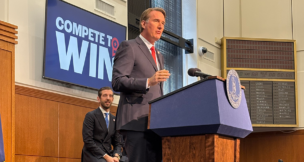Energy 2023: JOHN D. HEWA
In late April, residents in Louisa and Goochland counties were connected to broadband internet through a partnership between Rappahannock Electric Cooperative, Firefly Fiber Broadband and the two counties. The project’s completion marked significant progress in state efforts to digitally connect rural, underserved regions. Hewa, who became the cooperative’s president and CEO in 2020, e[...]
Energy 2023: DIANE LEOPOLD
Joining Dominion Energy in 1995 as a power station engineer and rising to chief operating officer in 2020, Leopold is responsible for all the Fortune 500 utility’s operating segments, including Dominion’s branches in Virginia and South Carolina, and its gas distribution and contracted assets division. During her 28-year career, Leopold has led Dominion’s gas infrastructure [&he[...]
Dominion, Dulles solar project to power 37,000 Va. homes
A massive solar project that will soon begin to take shape at Washington Dulles International Airport will not only have the ability to power 37,000 Virginia homes, but will also send a message to travelers about the power of clean energy, officials said Tuesday during a ceremonial groundbreaking for the 835-acre Dulles Solar and Storage project. […]
SWVA ‘ideal’ for small nuclear reactors, study says
Sites in Dickenson, Lee, Scott and Wise counties and the city of Norton would be “ideal” for installing small modular nuclear reactors (SMRs), according to a state-funded feasibility study released Monday. Examining the technical feasibility, safety considerations and economic viability of locating small reactors in Southwest Virginia, the study conducted by Reston-based Dominion Engin[...]
Data center park headed for Surry County
A Middleburg developer plans to build at least 30 data centers on a 641-acre plot next to the Surry Nuclear Power Station in Surry County, with the possibility of a hydrogen and nuclear-powered green energy production facility in the future, the county announced Wednesday. John Andrews, CEO of Middleburg-based Green Energy Partners LLC of Virginia, […]
Balance of power
Chris Rawlings was a mechanic who wanted to be a pilot. He left the Marine Corps in 2008 after deploying twice to Iraq, where he supervised an aircraft maintenance team, going on to perform similar duties as a civilian contractor in a hangar at Fort Eustis. But his plan was to get back into the […]
Youngkin announces $8.1M in GO Virginia grants
A variety of projects around the state intended to spur economic and workforce development will get a boost from $8.1 million in state GO Virginia grants, Gov. Glenn Youngkin announced Friday. The 17 projects are expected to add hundreds of jobs. Nearly $4.8 million will fund two Virginia Tech projects, including one expected to build […]
SHARON SMOOT
Smoot is a unicorn — a Black woman overseeing 4,700 employees in the highly technical field of manufacturing components for nuclear reactors. Named last summer as head of the Lynchburg-based federal contractor’s nuclear division, Smoot spent 30 years as a civilian employee of the U.S. Navy, ultimately serving as executive director for logistics, maintenance and […]
Framatome CEO retiring; CFO to be promoted
Framatome Inc. President and CEO Gary Mignogna will retire July 1, and Chief Financial Officer Katherine Williams will succeed him, the Lynchburg-based nuclear reactor and fuel company announced Tuesday. Mignogna will become chairman of Framatome Inc.’s board upon his retirement. Williams, who will continue to serve as CFO, has worked for Framatome, a French nuclear […]
Southwest Virginia could get small modular nuclear reactor
In early October, Gov. Glenn Youngkin announced his goal of developing a small modular nuclear reactor (SMR) in Southwest Virginia within 10 years, part of a plan to make the region an epicenter of energy innovation. Not long after, Youngkin said he planned to allocate $10 million to create the Virginia Power Innovation Fund, with […]
Crowded out
Election years are not the time to make waves in Virginia’s legislature, says Greg Habeeb, a former Roanoke delegate who now advises clients pursuing legislation in the General Assembly. Big changes — the kind the state saw during the Democrats’ two years of full legislative control in 2020 and 2021 — are expected to be […]
BWXT begins production of fuel for 1st U.S. microreactor
Lynchburg-based BWX Technologies Inc. has begun producing the nuclear fuel that will power the first microreactor built and operated in the United States, the company announced Wednesday. BWXT will manufacture a nuclear core for Project Pele under a $37 million award from the Idaho National Laboratory, as well as tristructural isotropic particle fuel, known as […]






















